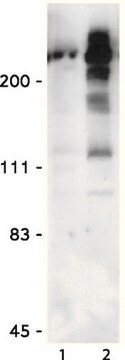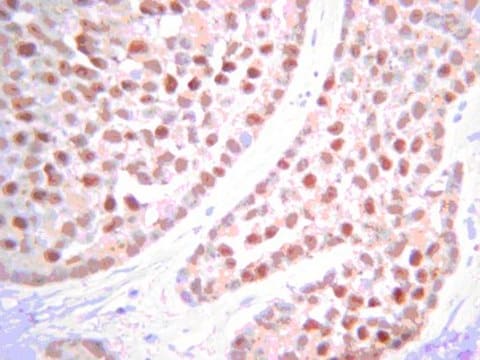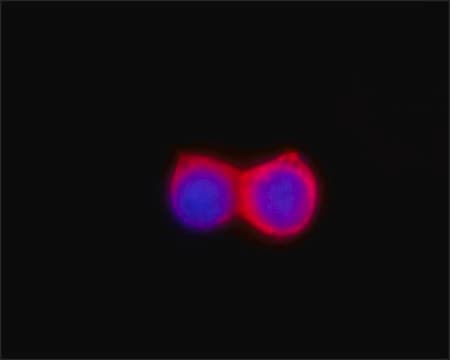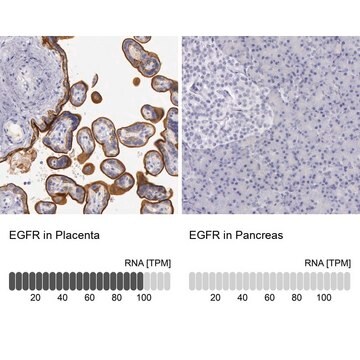03-241
RIPAb+ PUM2 Antibody
from rabbit, purified by affinity chromatography
Synonyme(s) :
pumilio homolog 2 (Drosophila), pumilio homolog 2, pumilio (Drosphila) homolog 2
About This Item
Produits recommandés
Source biologique
rabbit
Niveau de qualité
Clone
polyclonal
Produit purifié par
affinity chromatography
Espèces réactives
human, rhesus macaque, mouse
Réactivité de l'espèce (prédite par homologie)
chimpanzee (based on 100% sequence homology), rhesus monkey (based on 100% sequence homology), canine (based on 100% sequence homology)
Fabricant/nom de marque
RIPAb+
Upstate®
Technique(s)
RIP: suitable
immunocytochemistry: suitable
immunohistochemistry: suitable (paraffin)
western blot: suitable
Isotype
IgG2a
Numéro d'accès NCBI
Numéro d'accès UniProt
Conditions d'expédition
dry ice
Informations sur le gène
human ... PUM2(23369)
Description générale
PUM2 is a sequence-specific RNA-binding protein that regulates translation and mRNA stability by binding to the 3′-UTR of mRNA targets. The PUM class of proteins plays an active role in the sustainability of mitotic stem cell proliferation and the regulation of cell development and differentiation.
Spécificité
Immunogène
Application
Stem Cell Research
RNA Metabolism & Binding Proteins
Representative lot data.
Mouse embryonic stem cell lysate was resolved by electrophoresis, transferred to PVDF membranes and probed with Anti-Pumilio 2 (PUM2) 1 µg/mL. Proteins were visualized using a Donkey Anti-Rabbit IgG conjugated to HRP and chemiluminescence detection system.
Arrow indicates PUM2 (~120 kDa).
Note: A non-specific band may be observed at ~48 kDa in some lysates. (Figure 2).
Immunohistochemistry (Parafin) Analysis:
Representative lot data.
Paraffin-embedded human testis (Fig. 3A) and human teratoma (Fig. 3B) tissues were prepared using heat-induced epitope retrieval in citrate buffer, pH 6.0. Immunostaining was performed using a 1:400 dilution of Anti-Pumilio 2 (PUM2). Reactivity was detected using the IHC-Select Detection Kit (Cat. No. DAB050). Staining pattern appears to be restricted to primary spermatocytes with no Sertoli cell involvement, as expected.
Immunocytochemistry Analysis:
Representative lot data.
Confocal fluorescent analysis of mouse and human embryonic stem cells using Anti-Pumilio 2 (PUM2) (Red). Actin filaments have been labeled with Alexa Fluor™ 488 dye - Phalloidin (Green). Nucleus is stained with DAPI (Blue). (Figure 4) This antibody positively stains the nucleus and cytosol.
Conditionnement
Qualité
Representative lot data.
RIP Lysate prepared from HeLa cells (2 X 10E7 cell equivalents per IP) were subjected to immunoprecipitation using 5 µg of either a normal rabbit IgG or 5 µg of Anti-PUM2 antibody and the Magna RIP® RNA Binding Protein Immunoprecipitation Kit (Cat. # 17-700).
Successful immunoprecipitation of PUM2-associated RNA was verified by qPCR using RIP Primers, NFKBIA mRNA, (Figure 1).
Please refer to the Magna RIP (Cat. # 17-700) or EZ-Magna RIP (Cat. # 17-701) protocol for experimental details.
Description de la cible
Non specific band may be observed at 48 kDa
Forme physique
Anti-PUM2 (Rabbit Polyclonal). One vial containing 50 µg of affinity purified polyclonal in buffer containing 0.1 M Tris-Glycine (pH 7.4), 150 mM NaCl, with 0.05% sodium azide, before the addition of 30% glycerol. Store at -20°C.
Concentration: 0.7 mg/mL
Normal Rabbit IgG. One vial containing 125 µg Rabbit IgG in 125 µL storage buffer containing 0.05% sodium azide. Store at -20°C.
RIP Primers, NFKBIA mRNA. One vial containing 75 μL of each primer (5 μM) specific for a region of the human NFKBIA mRNA. Store at -20°C.
FOR: GCT ATT CTC CCT ACC AGC TC
REV: CAG TCA TCA TAG GGC AGC TC
Stockage et stabilité
Note: Variability in freezer temperatures below -20°C may cause glycerol containing solutions to become frozen during storage.
Remarque sur l'analyse
Includes normal rabbit IgG and primers specific for human NFKBIA mRNA.
Autres remarques
Informations légales
Clause de non-responsabilité
Code de la classe de stockage
10 - Combustible liquids
Certificats d'analyse (COA)
Recherchez un Certificats d'analyse (COA) en saisissant le numéro de lot du produit. Les numéros de lot figurent sur l'étiquette du produit après les mots "Lot" ou "Batch".
Déjà en possession de ce produit ?
Retrouvez la documentation relative aux produits que vous avez récemment achetés dans la Bibliothèque de documents.
Notre équipe de scientifiques dispose d'une expérience dans tous les secteurs de la recherche, notamment en sciences de la vie, science des matériaux, synthèse chimique, chromatographie, analyse et dans de nombreux autres domaines..
Contacter notre Service technique








